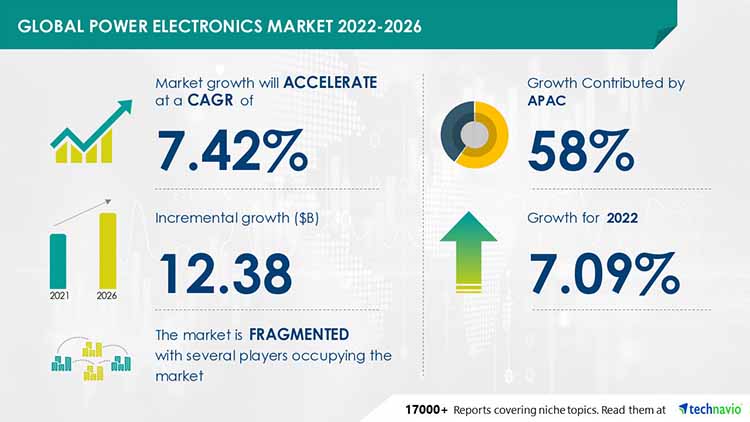NEW YORK, Aug. 30, 2022 /PRNewswire/ — The power electronics market size is expected to grow by USD 12.38 billion from 2021 to 2026, progressing at a CAGR of 7.42% as per the latest market forecast report by Technavio. The report also provides the market impact and new opportunities created due to the COVID-19 pandemic. 58% of the market’s growth will originate from APAC during the forecast period. China, Japan, and South Korea are the key markets for the power electronics market in APAC. Market growth in this region will be faster than the growth of the market in other regions. The increase in demand for power in developing nations will facilitate the power electronics market growth in APAC over the forecast period.

Power Electronics Market: Segmentation Analysis
The market research report segments the power electronics market by Product (Discretes and Modules) and Geography (APAC, Europe, North America, South America, and the Middle East and Africa).
- Revenue Generating Segment – The power electronics market share growth in the discrete segment will be significant for revenue generation. Discretes are used in consumer electronic goods and are primarily silicon-based. Most of the demand is for applications like consumer electronics and LED lighting systems. They require being optimized for power density while being placed in a module. The effort for searching and procuring discrete components is high and can be saved when modules are procured directly. Such an increase in demand will drive the segment growth during the forecast period.
Power Electronics Market: Major Driver
- The increased adoption of renewable energy is one of the key drivers supporting the power electronics market growth.
- For instance, the Renewable Energy Growth Program initiated by the US Department of Energy in 2015 got an extension till 2029. This program aims at producing 40 MW of combined renewable energy per year up to 2029, which includes solar, wind, hydropower, and anaerobic digestion projects.
- The projects are classified into small, medium, or large, based on the power output. This program offers opportunities to various commercial, government, non-profit, and other institutions to participate and get incentivized for meeting power production targets based on their category. Furthermore, this program enables manufacturers in the power electronics market to supply equipment to the participants. Thus, implementations of such programs will drive the market during the forecast period.
Power Electronics Market: Major Trends
- The rise in the adoption of smart grids is another factor supporting the power electronics market growth.
- A smart grid is an integrated network that connects all the assets of a power network, namely generation, transmission, distribution, and consumption. One of the main features of a smart grid is its ability to generate large volumes of data.
- The vast amount of information generated, coupled with variable power consumption sources, such as automation devices, sensors, and other smart devices, broadens the opportunities for utilities to handle multiple databases and synchronize them. With the help of a power utility monitoring system, this data can be used as a diagnostic tool for corrective action. However, the implementation of smart grids has been accelerated across the world due to the increase in power outages and the high costs associated with them, regulations that mandate the increased use of renewables, and the need for enhanced efficiency. These factors are driving the market growth.
The competitive scenario provided in the Power Electronics Market Report analyzes, evaluates, and positions companies based on various performance indicators. Some of the factors considered for this analysis include the financial performance of companies over the past few years, growth strategies, product innovations, new product launches, investments, growth in market share, etc.
| Power Electronics Market Scope | |
| Report Coverage | Details |
| Page number | 120 |
| Base year | 2021 |
| Forecast period | 2022-2026 |
| Growth momentum & CAGR | Accelerate at a CAGR of 7.42% |
| Market growth 2022-2026 | USD 12.38 billion |
| Market structure | Fragmented |
| YoY growth (%) | 7.09 |
| Regional analysis | APAC, Europe, North America, South America, Middle East, and Africa |
| Performing market contribution | APAC at 58% |
| Key consumer countries | US, China, Japan, South Korea, and Germany |
| Competitive landscape | Leading companies, competitive strategies, consumer engagement scope |
| Companies profiled | ABB Ltd., Alcon Electronics Pvt. Ltd., Analog Devices Inc., Danfoss AS, Fuji Electric Co. Ltd., General Electric Co., Infineon Technologies AG, Kerala State Electronics Development Corp. Ltd., Magna Power Electronics, Mitsubishi Electric Corp., NXP Semiconductors NV, OM Semiconductor Corp., Power Electronics, Renesas Electronics Corp., Siemens Energy AG, STMicroelectronics NV, Texas Instruments Inc., Toshiba Corp., Vitesco Technologies Group AG, and Arete and Cocchi Technology |
| Market Dynamics | Parent market analysis, Market growth inducers and obstacles, Fast-growing and slow-growing segment analysis, COVID-19 impact and future consumer dynamics, and market condition analysis for the forecast period. |
| Customization purview | If our report has not included the data that you are looking for, you can reach out to our analysts and get segments customized. |
Table of Content
1 Executive Summary
- 1.1 Market Overview
- Exhibit 01: Executive Summary – Chart on Market Overview
- Exhibit 02: Executive Summary – Data Table on Market Overview
- Exhibit 03: Executive Summary – Chart of Global Market Characteristics
- Exhibit 04: Executive Summary – Chart of Market by Geography
- Exhibit 05: Executive Summary – Chart on Market Segmentation by Product
- Exhibit 06: Executive Summary – Chart on Incremental Growth
- Exhibit 07: Executive Summary – Data Table on Incremental Growth
- Exhibit 08: Executive Summary – Chart on Vendor Market Positioning
2 Market Landscape
- 2.1 Market ecosystem
- Exhibit 09: Parent market
- Exhibit 10: Market Characteristics
3 Market Sizing
- 3.1 Market definition
- Exhibit 11: Offerings of vendors included in the market definition
- 3.2 Market segment analysis
- Exhibit 12: Market segments
- 3.3 Market size 2021
- 3.4 Market outlook: Forecast for 2021-2026
- Exhibit 13: Chart on Global – Market size and forecast 2021-2026 ($ billion)
- Exhibit 14: Data Table on Global – Market size and forecast 2021-2026 ($ billion)
- Exhibit 15: Chart on Global Market: Year-over-year growth 2021-2026 (%)
- Exhibit 16: Data Table on Global Market: Year-over-year growth 2021-2026 (%)
4 Five Forces Analysis
- 4.1 Five forces summary
- Exhibit 17: Five forces analysis – Comparison between 2021 and 2026
- 4.2 Bargaining power of buyers
- Exhibit 18: Bargaining power of buyers – Impact of key factors in 2021 and 2026
- 4.3 Bargaining power of suppliers
- Exhibit 19: Bargaining power of suppliers – Impact of key factors in 2021 and 2026
- 4.4 Threat of new entrants
- Exhibit 20: Threat of new entrants – Impact of key factors in 2021 and 2026
- 4.5 Threat of substitutes
- Exhibit 21: Threat of substitutes – Impact of key factors in 2021 and 2026
- 4.6 Threat of rivalry
- Exhibit 22: Threat of rivalry – Impact of key factors in 2021 and 2026
- 4.7 Market condition
- Exhibit 23: Chart on Market condition – Five forces 2021 and 2026
5 Market Segmentation by Product
- 5.1 Market segments
- Exhibit 24: Chart on Product – Market share 2021-2026 (%)
- Exhibit 25: Data Table on Product – Market share 2021-2026 (%)
- 5.2 Comparison by Product
- Exhibit 26: Chart on Comparison by Product
- Exhibit 27: Data Table on Comparison by Product
- 5.3 Discretes – Market size and forecast 2021-2026
- Exhibit 28: Chart on Discretes – Market size and forecast 2021-2026 ($ billion)
- Exhibit 29: Data Table on Discretes – Market size and forecast 2021-2026 ($ billion)
- Exhibit 30: Chart on Discretes – Year-over-year growth 2021-2026 (%)
- Exhibit 31: Data Table on Discretes – Year-over-year growth 2021-2026 (%)
- 5.4 Modules – Market size and forecast 2021-2026
- Exhibit 32: Chart on Modules – Market size and forecast 2021-2026 ($ billion)
- Exhibit 33: Data Table on Modules – Market size and forecast 2021-2026 ($ billion)
- Exhibit 34: Chart on Modules – Year-over-year growth 2021-2026 (%)
- Exhibit 35: Data Table on Modules – Year-over-year growth 2021-2026 (%)
- 5.5 Market opportunity by Product
- Exhibit 36: Market opportunity by Product ($ billion)
6 Customer Landscape
- 6.1 Customer landscape overview
- Exhibit 37: Analysis of price sensitivity, lifecycle, customer purchase basket, adoption rates, and purchase criteria
7 Geographic Landscape
- 7.1 Geographic segmentation
- Exhibit 38: Chart on Market share by geography 2021-2026 (%)
- Exhibit 39: Data Table on Market share by geography 2021-2026 (%)
- 7.2 Geographic comparison
- Exhibit 40: Chart on Geographic comparison
- Exhibit 41: Data Table on Geographic comparison
- 7.3 APAC – Market size and forecast 2021-2026
- Exhibit 42: Chart on APAC – Market size and forecast 2021-2026 ($ billion)
- Exhibit 43: Data Table on APAC – Market size and forecast 2021-2026 ($ billion)
- Exhibit 44: Chart on APAC – Year-over-year growth 2021-2026 (%)
- Exhibit 45: Data Table on APAC – Year-over-year growth 2021-2026 (%)
- 7.4 Europe – Market size and forecast 2021-2026
- Exhibit 46: Chart on Europe – Market size and forecast 2021-2026 ($ billion)
- Exhibit 47: Data Table on Europe – Market size and forecast 2021-2026 ($ billion)
- Exhibit 48: Chart on Europe – Year-over-year growth 2021-2026 (%)
- Exhibit 49: Data Table on Europe – Year-over-year growth 2021-2026 (%)
- 7.5 North America – Market size and forecast 2021-2026
- Exhibit 50: Chart on North America – Market size and forecast 2021-2026 ($ billion)
- Exhibit 51: Data Table on North America – Market size and forecast 2021-2026 ($ billion)
- Exhibit 52: Chart on North America – Year-over-year growth 2021-2026 (%)
- Exhibit 53: Data Table on North America – Year-over-year growth 2021-2026 (%)
- 7.6 South America – Market size and forecast 2021-2026
- Exhibit 54: Chart on South America – Market size and forecast 2021-2026 ($ billion)
- Exhibit 55: Data Table on South America – Market size and forecast 2021-2026 ($ billion)
- Exhibit 56: Chart on South America – Year-over-year growth 2021-2026 (%)
- Exhibit 57: Data Table on South America – Year-over-year growth 2021-2026 (%)
- 7.7 Middle East and Africa – Market size and forecast 2021-2026
- Exhibit 58: Chart on Middle East and Africa – Market size and forecast 2021-2026 ($ billion)
- Exhibit 59: Data Table on Middle East and Africa – Market size and forecast 2021-2026 ($ billion)
- Exhibit 60: Chart on Middle East and Africa – Year-over-year growth 2021-2026 (%)
- Exhibit 61: Data Table on Middle East and Africa – Year-over-year growth 2021-2026 (%)
- 7.8 China – Market size and forecast 2021-2026
- Exhibit 62: Chart on China – Market size and forecast 2021-2026 ($ billion)
- Exhibit 63: Data Table on China – Market size and forecast 2021-2026 ($ billion)
- Exhibit 64: Chart on China – Year-over-year growth 2021-2026 (%)
- Exhibit 65: Data Table on China – Year-over-year growth 2021-2026 (%)
- 7.9 US – Market size and forecast 2021-2026
- Exhibit 66: Chart on US – Market size and forecast 2021-2026 ($ billion)
- Exhibit 67: Data Table on US – Market size and forecast 2021-2026 ($ billion)
- Exhibit 68: Chart on US – Year-over-year growth 2021-2026 (%)
- Exhibit 69: Data Table on US – Year-over-year growth 2021-2026 (%)
- 7.10 Japan – Market size and forecast 2021-2026
- Exhibit 70: Chart on Japan – Market size and forecast 2021-2026 ($ billion)
- Exhibit 71: Data Table on Japan – Market size and forecast 2021-2026 ($ billion)
- Exhibit 72: Chart on Japan – Year-over-year growth 2021-2026 (%)
- Exhibit 73: Data Table on Japan – Year-over-year growth 2021-2026 (%)
- 7.11 Germany – Market size and forecast 2021-2026
- Exhibit 74: Chart on Germany – Market size and forecast 2021-2026 ($ billion)
- Exhibit 75: Data Table on Germany – Market size and forecast 2021-2026 ($ billion)
- Exhibit 76: Chart on Germany – Year-over-year growth 2021-2026 (%)
- Exhibit 77: Data Table on Germany – Year-over-year growth 2021-2026 (%)
- 7.12 South Korea – Market size and forecast 2021-2026
- Exhibit 78: Chart on South Korea – Market size and forecast 2021-2026 ($ billion)
- Exhibit 79: Data Table on South Korea – Market size and forecast 2021-2026 ($ billion)
- Exhibit 80: Chart on South Korea – Year-over-year growth 2021-2026 (%)
- Exhibit 81: Data Table on South Korea – Year-over-year growth 2021-2026 (%)
- 7.13 Market opportunity by geography
- Exhibit 82: Market opportunity by geography ($ billion)
8 Drivers, Challenges, and Trends
- 8.1 Market drivers
- 8.2 Market challenges
- 8.3 Impact of drivers and challenges
- Exhibit 83: Impact of drivers and challenges in 2021 and 2026
- 8.4 Market trends
9 Vendor Landscape
- 9.1 Overview
- 9.2 Vendor landscape
- Exhibit 84: Overview on Criticality of inputs and Factors of differentiation
- 9.3 Landscape disruption
- Exhibit 85: Overview on factors of disruption
- 9.4 Industry risks
- Exhibit 86: Impact of key risks on business
10 Vendor Analysis
- 10.1 Vendors covered
- Exhibit 87: Vendors covered
- 10.2 Market positioning of vendors
- Exhibit 88: Matrix on vendor position and classification
- 10.3 Analog Devices Inc.
- Exhibit 89: Analog Devices Inc. – Overview
- Exhibit 90: Analog Devices Inc. – Product / Service
- Exhibit 91: Analog Devices Inc. – Key offerings
- 10.4 Fuji Electric Co. Ltd.
- Exhibit 92: Fuji Electric Co. Ltd. – Overview
- Exhibit 93: Fuji Electric Co. Ltd. – Business segments
- Exhibit 94: Fuji Electric Co. Ltd. – Key offerings
- Exhibit 95: Fuji Electric Co. Ltd. – Segment focus
- 10.5 Infineon Technologies AG
- Exhibit 96: Infineon Technologies AG – Overview
- Exhibit 97: Infineon Technologies AG – Business segments
- Exhibit 98: Infineon Technologies AG – Key news
- Exhibit 99: Infineon Technologies AG – Key offerings
- Exhibit 100: Infineon Technologies AG – Segment focus
- 10.6 Mitsubishi Electric Corp.
- Exhibit 101: Mitsubishi Electric Corp. – Overview
- Exhibit 102: Mitsubishi Electric Corp. – Business segments
- Exhibit 103: Mitsubishi Electric Corp. – Key news
- Exhibit 104: Mitsubishi Electric Corp. – Key offerings
- Exhibit 105: Mitsubishi Electric Corp. – Segment focus
- 10.7 NXP Semiconductors NV
- Exhibit 106: NXP Semiconductors NV – Overview
- Exhibit 107: NXP Semiconductors NV – Product / Service
- Exhibit 108: NXP Semiconductors NV – Key news
- Exhibit 109: NXP Semiconductors NV – Key offerings
- 10.8 OM Semiconductor Corp.
- Exhibit 110: OM Semiconductor Corp. – Overview
- Exhibit 111: OM Semiconductor Corp. – Business segments
- Exhibit 112: OM Semiconductor Corp. – Key offerings
- Exhibit 113: OM Semiconductor Corp. – Segment focus
- 10.9 Renesas Electronics Corp.
- Exhibit 114: Renesas Electronics Corp. – Overview
- Exhibit 115: Renesas Electronics Corp. – Business segments
- Exhibit 116: Renesas Electronics Corp. – Key offerings
- Exhibit 117: Renesas Electronics Corp. – Segment focus
- 10.10 STMicroelectronics NV
- Exhibit 118: STMicroelectronics NV – Overview
- Exhibit 119: STMicroelectronics NV – Business segments
- Exhibit 120: STMicroelectronics NV – Key news
- Exhibit 121: STMicroelectronics NV – Key offerings
- Exhibit 122: STMicroelectronics NV – Segment focus
- 10.11 Texas Instruments Inc.
- Exhibit 123: Texas Instruments Inc. – Overview
- Exhibit 124: Texas Instruments Inc. – Business segments
- Exhibit 125: Texas Instruments Inc. – Key news
- Exhibit 126: Texas Instruments Inc. – Key offerings
- Exhibit 127: Texas Instruments Inc. – Segment focus
- 10.12 Toshiba Corp.
- Exhibit 128: Toshiba Corp. – Overview
- Exhibit 129: Toshiba Corp. – Business segments
- Exhibit 130: Toshiba Corp. – Key offerings
- Exhibit 131: Toshiba Corp. – Segment focus
11 Appendix
- 11.1 Scope of the report
- 11.2 Inclusions and exclusions checklist
- Exhibit 132: Inclusions checklist
- Exhibit 133: Exclusions checklist
- 11.3 Currency conversion rates for US$
- Exhibit 134: Currency conversion rates for US$
- 11.4 Research methodology
- Exhibit 135: Research methodology
- Exhibit 136: Validation techniques employed for market sizing
- Exhibit 137: Information sources
- 11.5 List of abbreviations
- Exhibit 138: List of abbreviations













